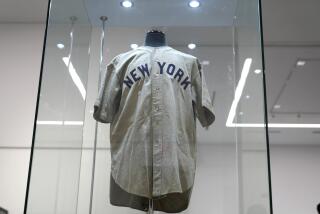Baseball Players Have Been in the Cards Since 1887
For almost as long as men have been paid to play baseball, they’ve had their likenesses featured on pasteboard. And for just as long, people have been saving those pictures.
For a quarter of a century, beginning in 1887, pictures of baseball players were issued with packages of cigarettes. Notable was a set of more than 2,300 variations issued with Old Judge Cigarettes over a four-year period in the late 19th Century, and a popular collection of 524 from 1909-11 produced to promote 18 brands of cigarettes owned by the American Tobacco Co.
While the cards were likely targeted to the children of the buyer, many must have been kept by adults, judging by the large number still in circulation.
Caramel and chewing gum companies were the primary producers of baseball cards between the World Wars, notably the Goudey Gum Co. of Boston in the ‘30s. Card collecting among adults was an underground enterprise. Collectors conducted trades by mail, and with no price guides or checklists available, relied on each other for information. The names of pioneers like Frank Nagy, John Wagner, Woody Gelman, Buck Barker and Charles Bray, while unfamiliar to the average sports fan, are as well-known to longtime hobbyists as those of Ty Cobb and Lou Gehrig.
The hobby’s Babe Ruth, though, was Jefferson Burdick, a thin, bespectacled native of Syracuse, who traveled the country in the ‘30s, ‘40s and ‘50s putting together one of the most impressive collections of trade cards of all sorts. In 1960, he coordinated the compiling of the first guide to card issues. Several years later, Burdick willed his collection to the Metropolitan Museum in New York. Despite arthritis, he spent the last weeks of his life at the museum mounting his collection in albums, and died just days after completing the task.
After World War II, the baseball-card field belonged to two chewing gum companies, Topps of Brooklyn, N.Y., and Bowman of Philadelphia, until Topps bought out Bowman in 1955. Topps maintained a monopoly until a court decision in 1980 opened up competition.
Collectors began coming out of the woodwork in the ‘70s, forming regional clubs and holding weekend shows. The hobby got guidelines in 1979, when Jim Beckett published the first edition of the Sports Americana Baseball Card Price Guide. His monthly guide is recognized as the hobby’s bible.
The hobby grew in acceptance during the ‘80s, as the value of cards quickly increased. After the stock market’s faltering in 1987, many investors took their money out of stocks and put it into sports collectibles, pushing card prices higher.
All facets of the industry have grown during the past five years. Upper Deck of Yorba Linda, Score, Pro Set and Impel began producing sets in a several sports. Weekend card shows have proliferated--on any given weekend, a Southland collector has a choice of three or four--and most cities have at least one collectibles store. And the hobby press now features more than a dozen publications, including the weekly Sports Collectors Digest and the monthly Baseball Hobby News and Tuff Stuff.
The hobby also has managed to gain the attention of the non-collecting sports fan, although often for off-beat reasons:
--A 1989 card of Billy Ripken got headlines when it slipped past the proofreaders at Fleer with profanity visible on a bat handle.
--On the night of the day Pete Rose was suspended from baseball two years ago, he turned up on a television shopping network to promote a line of collectibles.
--This spring, a dealer in suburban Chicago sued a 13-year-old who had purchased a Nolan Ryan card worth about $1,200 from a befuddled clerk for $12. They agreed to auction the card for charity; it drew a winning bid of $5,000.
More to Read
Go beyond the scoreboard
Get the latest on L.A.'s teams in the daily Sports Report newsletter.
You may occasionally receive promotional content from the Los Angeles Times.










